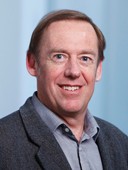Prof. em. Dr. Roy Smith

Prof. em. Dr. Roy Smith
Retired Adjunct Professor at the Department of Information Technology and Electrical Engineering
Additional information
Research area
Professor Smith’s field of expertise is feedback control systems and automation, in which he is known as an experimentalist and design engineer as well as a theorist.
His research interests include the identification and control of uncertain systems, particularly the relationship between experimental data and theoretical models; design methodologies for uncertain constrained systems; and distributed estimation, communication and control systems.
On the applications side, he has applied his research to a variety of experimental testbeds, including process control systems, automotive engines, flexible space structures, aeromanoeuvring Mars entry vehicles, formation flying of spacecraft, magnetically levitated bearings, power generating kites, and energy control for buildings and districts.
He has been a long time consultant to the NASA Jet Propulsion Laboratory on guidance, navigation and control aspects of interplanetary and deep space science spacecraft.
Roy Smith has been an Adjunct Professor at the Automatic Control Laboratory in the Department of Information Technology and Electrical Engineering since 2011.
He was born in Wellington, New Zealand, in 1958 and completed his B.E., Hons. (Electrical) and M.E. (Electrical) degrees at the University of Canterbury, New Zealand, in 1980 and 1981 respectively.
Between 1981 and 1983, he worked as an electrical engineer on a series of projects for Victoria University, Wellington, and the New Zealand Energy Research and Development Committee; Worley Downey Mandeno Ltd; and the Institute of Nuclear Sciences in New Zealand. From 1983 to 1985, he was an electrical engineer and project manager for Olson Engineering Inc. in California, USA.
In 1985 he embarked on his postgraduate studies at the California Institute of Technology, Pasadena, CA, USA, where he received an M.S. and Ph.D. in electrical engineering in 1986 and 1990 respectively. From 1989 to 1990, he was a postdoctoral scholar at the California Institute of Technology and the NASA Jet Propulsion Laboratory.
In 1990 he joined the faculty of the University of California, Santa Barbara, CA, USA, where he held the positions of Assistant Professor from 1990 to 1996, Associate Professor from 1996 to 2002, and Professor from 2002 to 2010. Professor Smith has also held Visiting Professor positions at the University of California, Berkeley, USA; the Indian Institute of Science, Bangalore, India; Cambridge University, Great Britain; and the Kungliga Tekniska Högskolan, Stockholm, Sweden.
Professor Smith was a consultant to the NASA Jet Propulsion Laboratory, CA, USA, from 1990 to 1992 and from 1995 to 2006 on flexible space structures, aeromanoeuvring entry vehicles on Mars, and formation flying of science spacecraft in deep space. Between 1997 and 1998, he was a consultant to Motion Engineering, Inc., CA, USA, on the development of time-optimal motion control algorithms. He has also consulted for Musyn Inc, MN, USA and Integrated Systems Inc., CA, USA, on the development of automation design software. From 2008 to 2010 he was a consultant for LaunchPoint, CA, USA on the development of magnetically levitated bearings, and precision control and coordination algorithms for spacecraft.
Honours
| Year | Distinction |
|---|---|
| 2024 | Life Fellow of the Institute of Electrical and Electronic Engineers (IEEE) |
| 2020 | Fellow of the International Federation of Automatic Control (IFAC) |
| 2011 | Fellow of the Institute of Electrical and Electronic Engineers (IEEE) |
| 2008 | Associate Fellow of the American Institute of Aeronautics and Astronautics (AIAA) |
Additional information
In 1990 Professor Smith worked with the Kanchenjunga School Project development charity, installing solar powered vaccine refrigerators in a remote region of Nepal. From 2007 to 2016 he was active with Engineers Without Borders, USA, advising a student group on engineering infrastructure designs for a remote village in Kenya. The infrastructure developed to date includes rainwater collection systems, electrification of a health clinic, borehole drilling, development of a well pump and water distribution system, and an incinerator for medical waste. Each year between 2008 and 2016 he travelled with a team of students to a village on the shore of Lake Victoria, Kenya, to complete the installations.
Course Catalogue
Autumn Semester 2025
| Number | Unit |
|---|---|
| 227-0689-00L | System Identification |